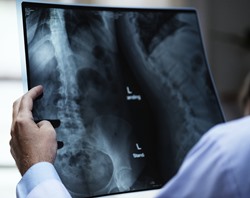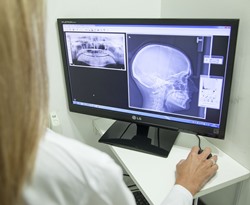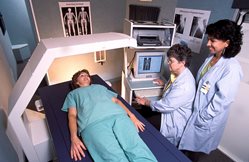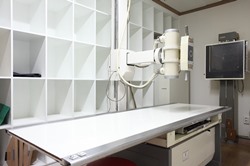How to Select the Best X-Ray Tech Course near Sacred Heart Minnesota
 So you have made the decision to enroll in an X-ray tech school near Sacred Heart MN in order to learn to be a radiologic technologist. And now that you have decided to enter the gratifying field of healthcare, just how do you set about picking the right college and program so that you will receive the appropriate training to become a skilled practitioner? And since the majority of states do mandate that radiology techs become licensed, depending on where you subsequently practice you may need training to pass a licensing test. So it’s essential that you assess each of the X-ray technician schools you are looking at so that you can evaluate each program. Many prospective students begin by searching for colleges or technical schools that are within driving distance of their homes. Next, they compare tuition and often gravitate toward the lowest cost. But while location and cost should be taken into consideration, there are additional critical qualifications also. For instance, you need to find out whether or not the radiology tech schools are accredited, or if they offer internship programs. These inquiries and others you should ask the X-ray Tech schools you are evaluating are provided later in this post. But first, let’s discuss what a radiology technician does and the credentials and education options that are available.
So you have made the decision to enroll in an X-ray tech school near Sacred Heart MN in order to learn to be a radiologic technologist. And now that you have decided to enter the gratifying field of healthcare, just how do you set about picking the right college and program so that you will receive the appropriate training to become a skilled practitioner? And since the majority of states do mandate that radiology techs become licensed, depending on where you subsequently practice you may need training to pass a licensing test. So it’s essential that you assess each of the X-ray technician schools you are looking at so that you can evaluate each program. Many prospective students begin by searching for colleges or technical schools that are within driving distance of their homes. Next, they compare tuition and often gravitate toward the lowest cost. But while location and cost should be taken into consideration, there are additional critical qualifications also. For instance, you need to find out whether or not the radiology tech schools are accredited, or if they offer internship programs. These inquiries and others you should ask the X-ray Tech schools you are evaluating are provided later in this post. But first, let’s discuss what a radiology technician does and the credentials and education options that are available.
Radiology Tech Work Summary in Sacred Heart MN
 There are multiple professional designations for x-ray techs (technologists or technicians). They can also be called radiologic technologists, radiologic technicians, radiology technicians or radiographers. No matter what the name, they all have the same principal job function, which is to utilize imaging machines to internally visualize patients for the objective of diagnosis and treatment. Some radiologic technologists might also administer radiation therapy for treating cancer. Some opt to work as generalists, while others may choose a specialization, for instance mammography. They can practice in Sacred Heart MN clinics, hospitals, family practices or outpatient diagnostic imaging centers. The imaging technologies that an X-Ray technologist might utilize include:
There are multiple professional designations for x-ray techs (technologists or technicians). They can also be called radiologic technologists, radiologic technicians, radiology technicians or radiographers. No matter what the name, they all have the same principal job function, which is to utilize imaging machines to internally visualize patients for the objective of diagnosis and treatment. Some radiologic technologists might also administer radiation therapy for treating cancer. Some opt to work as generalists, while others may choose a specialization, for instance mammography. They can practice in Sacred Heart MN clinics, hospitals, family practices or outpatient diagnostic imaging centers. The imaging technologies that an X-Ray technologist might utilize include:
- Traditional and specialized X-Rays
- Computerized tomography (CT) or “CAT” scans
- Magnetic resonance imaging (MRI)
- Sonography or ultrasound
- Fluoroscopy
Radiographers have to take care of their equipment and routinely assess its functionality and safety. They are additionally required to retain in-depth records of each of their diagnostic procedures. As health practitioners, they are held to a high professional standard and code of conduct.
Click Here For Free Information on X-Ray Tech Schools Near You!
X-Ray Technician Degrees Offered near Sacred Heart MN
 The primary prerequisite for enrolling in a radiology tech college is to have attained a high school diploma or equivalent. Radiologic technologist students have the option to earn either an Associate or a Bachelor’s Degree. An Associate Degree, which is the most common among technicians, usually requires 18 months to two years to finish depending on the program and course load. A Bachelor’s Degree will take longer at up to four years to complete and is more extensive in scope. Most students choose a degree major in Radiography, but there are additional related majors that may be appropriate as well. Something to bear in mind is that radiographer schools have a clinical training or lab component as part of their course of study. It may frequently be satisfied by taking part in an internship or externship program which a large number of colleges offer through local hospitals and clinics in Sacred Heart MN or their area. After you have graduated from any of the degree programs, you will need to abide by any licensing or certification requirements in Minnesota or the state you will be practicing in as applicable.
The primary prerequisite for enrolling in a radiology tech college is to have attained a high school diploma or equivalent. Radiologic technologist students have the option to earn either an Associate or a Bachelor’s Degree. An Associate Degree, which is the most common among technicians, usually requires 18 months to two years to finish depending on the program and course load. A Bachelor’s Degree will take longer at up to four years to complete and is more extensive in scope. Most students choose a degree major in Radiography, but there are additional related majors that may be appropriate as well. Something to bear in mind is that radiographer schools have a clinical training or lab component as part of their course of study. It may frequently be satisfied by taking part in an internship or externship program which a large number of colleges offer through local hospitals and clinics in Sacred Heart MN or their area. After you have graduated from any of the degree programs, you will need to abide by any licensing or certification requirements in Minnesota or the state you will be practicing in as applicable.
X-ray Technician Certification and Licensing
When you have graduated from an Radiologist program, based on the state where you will be practicing you may need to become licensed. Most states do require licensing, and their requirements vary so get in touch with your state. Currently, all states that do mandate licensure will recognize The American Registry of Radiologic Technologists (ARRT) certification exam for the purpose of licensing, but a number provide other options for testing also. A number of states also call for certification as part of the licensing procedure, otherwise it is voluntary. Having said that, many Sacred Heart area employers favor hiring radiology techs that are certified so it may increase your career options in and around Sacred Heart MN to become certified. ARRT’s certification program requires graduation from an approved program as well as a passing score on their rigorous exam. ARRT also demands re-certification every 2 years, which may be fulfilled with 24 credits of continuing ed, or by passing an exam.
Online X-Ray Tech Colleges
 As a component of every degree program, x-ray tech colleges will have practical or lab training included in their course of study. This is the same for online degree programs. So even though you can still obtain your online degree, a substantial portion of the training will be completed either in a school lab or in an internship off-campus. Practical training is usually provided in Sacred Heart MN family practices, medical clinics or hospitals in sponsorship with the colleges. However the online segment of the training can be accessed in the comfort of your Sacred Heart home. Students who keep working while obtaining their degree usually discover that the online approach to education is far more practical with their hectic schedules. Plus online programs are generally cheaper than on-campus options. In addition to lower tuition, expenses for study materials and commuting can be decreased as well. But just make sure that the online college you pick is accredited (more on the advantages of accreditation later). So if you are disciplined enough to learn with this less formalized type of training, then an online degree may be the best option for you.
As a component of every degree program, x-ray tech colleges will have practical or lab training included in their course of study. This is the same for online degree programs. So even though you can still obtain your online degree, a substantial portion of the training will be completed either in a school lab or in an internship off-campus. Practical training is usually provided in Sacred Heart MN family practices, medical clinics or hospitals in sponsorship with the colleges. However the online segment of the training can be accessed in the comfort of your Sacred Heart home. Students who keep working while obtaining their degree usually discover that the online approach to education is far more practical with their hectic schedules. Plus online programs are generally cheaper than on-campus options. In addition to lower tuition, expenses for study materials and commuting can be decreased as well. But just make sure that the online college you pick is accredited (more on the advantages of accreditation later). So if you are disciplined enough to learn with this less formalized type of training, then an online degree may be the best option for you.
Subjects to Ask X Ray Tech Programs
After you have selected the type of degree that you would like to earn, you can initiate the process of locating and assessing x-ray tech schools near Sacred Heart MN. You will also need to decide if you want to attend online classes or commute to a local campus. If you opt for the latter, then of course the location of the college will be relevant. The cost of tuition and ancillary expenses will be a determining factor as well. But along with location and cost, what more should you look at when reviewing schools? Well, you need to check out if the colleges are accredited, and if they provide internship or externship programs. To help you find out some of these essential details before you make your selection, we have put together a list of questions that you need to ask the programs you are considering.
Are the Radiology Technician Programs Accredited? Most radiology tech colleges have earned some form of accreditation, whether national or regional. Even so, it’s still important to confirm that the school and program are accredited. One of the most highly respected accrediting agencies in the field of radiology is the Joint Review Committee on Education in Radiologic Technology (JRCERT). Programs obtaining accreditation from the JRCERT have undergone an extensive examination of their teachers and course materials. If the program is online it can also earn accreditation from the Distance Education and Training Council, which focuses on distance or online learning. All accrediting organizations should be acknowledged by the U.S. Department of Education or the Council on Higher Education Accreditation. Along with ensuring a premium education, accreditation will also assist in acquiring financial aid and student loans, which are frequently not accessible for non-accredited colleges. Accreditation can also be a pre-requisite for licensing and certification as required. And a number of Sacred Heart MN health facilities will only hire a graduate of an accredited program for entry-level openings.
Are Internship Programs Provided? Inquire if the radiology technician colleges you are interested in have relationships with area clinics or hospitals for internship programs. Internships are not only a terrific means to obtain practical experience in a clinical setting, they are additionally a way to satisfy the clinical training requirement for most programs. As a secondary benefit, they can assist students and graduates form professional connections in the Sacred Heart MN health care community and assist with job placement.
Is Job Placement Help offered? You will undoubtedly want to hit the ground running after graduating, but finding that initial job in Sacred Heart MN in a new profession can be difficult without assistance. Ask if the radiographer schools you are reviewing have job placement programs and what their success rates are. High and rapid placement rates are a good indication that the schools have large networks and good relationships with Minnesota healthcare employers. It also corroborates that their students are highly regarded and in demand.
Where is the Program Located? For a lot of students, the school they select will need to be within commuting distance of their Sacred Heart MN home. Students who have chosen to attend online classes obviously will not have to concern themselves with the location of the campus. However, the availability of area internships will be of importance. One thing to consider is that if you choose to enroll in a college that is out of state or even out of your local area, you may be required to pay a higher tuition. State colleges often charge higher tuitions for out of state residents. And community colleges generally charge a higher tuition to those students that live outside of their districts.
How Big are the Classes ? Unless you are the kind of student that likes to sit far in the back of the classroom or get lost in the crowd, you will probably want a smaller class size. Small classes allow for more individual participation and personalized instruction. Ask the Sacred Heart MN colleges you are reviewing what the average teacher to student ratio is for their classes. If practical you may want to sit in on one or more classes before making your final decision. This will also give you a chance to speak with a few of the instructors and students to get their perspectives regarding the radiology technician program also.
Can the College Accommodate your Schedule? And last you need to confirm that the radiographer program you finally pick can provide the class schedule you need. This is particularly crucial if you opt to continue working while you attend classes. If you must schedule evening or weekend classes in the Sacred Heart MN area, check that they are offered. If you can only attend part-time, check if that is an option and how many credit hours or courses you would need to enroll in. Also, find out what the protocol is for making up any classes that you may miss due to illness, work or family obligations.
Guide to Part Time Radiologic Tech Schools Sacred Heart MN
 Selecting the appropriate x-ray technician college is a critical first step toward beginning a rewarding new career providing diagnostic medical services to patients. The suitable radiologic technologist must be in good physical condition. Radiology techs often stand for the majority of the workday and move and at times lift the patient to obtain the proper image. Prospects must also demonstrate an ability to pay strict attention to detail and to follow the safety requirements developed to protect both the patient and the medical team. X-Ray techs work very closely with patients, other technicians as well as the radiologists and other doctors. Possessing social skills is a necessity in order to have a good work environment and provide the best available patient care. You originally came to this website due to an interest in Guide to Part Time Radiologic Tech Schools and wanting more information on the topic Radiology X Ray Technician Programs. However, as we have discussed in this post, there are a number of questions that you should ask each college you are assessing prior to making your final selection. This is just as true whether you opt for an online school or commute to classes on campus. By asking the right questions you can evaluate and compare each school so you can focus your options before making your final choice. And with the appropriate training and your motivation to succeed, you can reach your goal to practice as a radiographer in Sacred Heart MN.
Selecting the appropriate x-ray technician college is a critical first step toward beginning a rewarding new career providing diagnostic medical services to patients. The suitable radiologic technologist must be in good physical condition. Radiology techs often stand for the majority of the workday and move and at times lift the patient to obtain the proper image. Prospects must also demonstrate an ability to pay strict attention to detail and to follow the safety requirements developed to protect both the patient and the medical team. X-Ray techs work very closely with patients, other technicians as well as the radiologists and other doctors. Possessing social skills is a necessity in order to have a good work environment and provide the best available patient care. You originally came to this website due to an interest in Guide to Part Time Radiologic Tech Schools and wanting more information on the topic Radiology X Ray Technician Programs. However, as we have discussed in this post, there are a number of questions that you should ask each college you are assessing prior to making your final selection. This is just as true whether you opt for an online school or commute to classes on campus. By asking the right questions you can evaluate and compare each school so you can focus your options before making your final choice. And with the appropriate training and your motivation to succeed, you can reach your goal to practice as a radiographer in Sacred Heart MN.
Other Minnesota Diagnostic Locations
Sacred Heart, Minnesota
As of the census[2] of 2010, there were 548 people, 235 households, and 139 families residing in the city. The population density was 553.5 inhabitants per square mile (213.7/km2). There were 282 housing units at an average density of 284.8 per square mile (110.0/km2). The racial makeup of the city was 98.5% White, 0.2% African American, 0.9% Native American, and 0.4% from other races. Hispanic or Latino of any race were 9.1% of the population.
There were 235 households of which 29.4% had children under the age of 18 living with them, 42.1% were married couples living together, 9.8% had a female householder with no husband present, 7.2% had a male householder with no wife present, and 40.9% were non-families. 35.7% of all households were made up of individuals and 19.2% had someone living alone who was 65 years of age or older. The average household size was 2.33 and the average family size was 3.08.
The median age in the city was 36.6 years. 26.3% of residents were under the age of 18; 6.8% were between the ages of 18 and 24; 24.2% were from 25 to 44; 24.8% were from 45 to 64; and 17.9% were 65 years of age or older. The gender makeup of the city was 48.5% male and 51.5% female.
